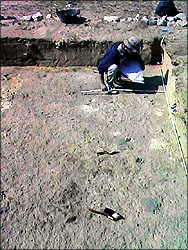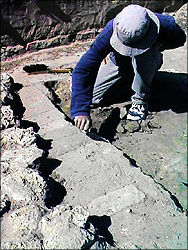
|
Newsflash
February 23, 1997:
Mysteries of the Mud Mass
In our excavation, the first and most important work to be done is to define
the architecture, which contains the artifacts we find. If we do this
correctly, our work for the rest of the season is made easier, since walls
and doorways can provide boundaries for several layers and give us clear
starting points for excavating. However, if these walls are not
well-preserved, consisting of only one or two courses of brick, a simple
mistake made in identifying them early on might unintentionally destroy
valuable clues to the story of our site.
 Fortunately, the area we are currently excavating is covered by a layer of
clean, yellow sand immediately below the modern debris. Almost everywhere,
once this sand is removed, we are confronted with an apparently uniform level
of grey mud mixed with pottery and large chunks of limestone. This "wash" of
mud, stone and ceramic is what is left of the mudbrick buildings we are
digging, after they had been abandoned and exposed to years of rain, wind and
sun. Under these conditions, unbaked mudbricks dissolve and re-harden many
times, their individual shapes and colors becoming mixed and obscured,
resulting in a confusing mass of mud which archaeologists call "tumble" (a
term for fallen walls). While we label this seemingly homogenous layer as a
separate "feature" (a term our project uses for any event which left or took
away material from the site), saving all the pottery, charcoal, stone tools
and bones we can, the real story of what happened inside these buildings, as
well as the walls of the buildings themselves, lies hidden underneath.
Sometimes, exposing these earlier features can be pretty tricky.
Fortunately, the area we are currently excavating is covered by a layer of
clean, yellow sand immediately below the modern debris. Almost everywhere,
once this sand is removed, we are confronted with an apparently uniform level
of grey mud mixed with pottery and large chunks of limestone. This "wash" of
mud, stone and ceramic is what is left of the mudbrick buildings we are
digging, after they had been abandoned and exposed to years of rain, wind and
sun. Under these conditions, unbaked mudbricks dissolve and re-harden many
times, their individual shapes and colors becoming mixed and obscured,
resulting in a confusing mass of mud which archaeologists call "tumble" (a
term for fallen walls). While we label this seemingly homogenous layer as a
separate "feature" (a term our project uses for any event which left or took
away material from the site), saving all the pottery, charcoal, stone tools
and bones we can, the real story of what happened inside these buildings, as
well as the walls of the buildings themselves, lies hidden underneath.
Sometimes, exposing these earlier features can be pretty tricky.
First, before we can remove this brown muddy material, we have to trowel and
clean the surface to more clearly delineate what loose bricks, pottery and
limestone rubble remain. Afterwards, photographs are taken and the
individual stones and sherds are drawn. Back in Boston we use these drawings,
which have elevations above sea level,to help us reconstruct the site.
Once we have properly recorded the surface of the mud mass, we approach each
square in the same way we think about our site as a whole. In much the same
way we formed hypotheses (scientific theories or guesses based on previous
evidence) about what our large building might be, which led, in turn, to our
choice of where to dig, we also have to form and test hypotheses
as to where mudbrick walls might be buried in their squares from the often
confusing jumble of pottery and mudbricks in the muddy mass.
 To this end there are often several clues. After the surface has been
troweled and then dried by the sun, the individual shapes and colors of the
bricks reappear. If these bricks are irregular and disjointed, it is a good
indication that the feature is mostly bricks which have fallen from a wall
and can be safely removed to expose intact architecture. Another clue is the
presence (or absence) of ceramic sherds. Although small fragments of pottery
as well as charcoal and stone chips were often scooped up with the mud when
the bricks were made, larger pieces of pottery usually indicate tumble, and
can even be banked up against an ancient wall, revealing its face. Using
these clues we normally see the underlying architecture as soon as the
obscuring tumble is removed.
To this end there are often several clues. After the surface has been
troweled and then dried by the sun, the individual shapes and colors of the
bricks reappear. If these bricks are irregular and disjointed, it is a good
indication that the feature is mostly bricks which have fallen from a wall
and can be safely removed to expose intact architecture. Another clue is the
presence (or absence) of ceramic sherds. Although small fragments of pottery
as well as charcoal and stone chips were often scooped up with the mud when
the bricks were made, larger pieces of pottery usually indicate tumble, and
can even be banked up against an ancient wall, revealing its face. Using
these clues we normally see the underlying architecture as soon as the
obscuring tumble is removed.
When we begin to uncover bricks which appear to be intact (still lying in the
wall in which they were laid), individual bricks can be defined by brushing
them with a stiff brush after they have dried out a little. Although the
ancient Egyptians did not use mortar or baked bricks at our site, the spaces
between their mudbricks are softer, and come loose when brushed. Using this
technique and noting the location of large sherds, we can decipher many of
the mysteries of the mud mass.
(previous newsflash)
(table of contents)
Photos: Carl Andrews
Pyramids Home | Pyramids | Excavation
Contents | Mail
|